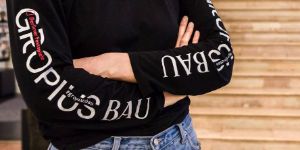
© Laura Fiorio
Gropius Bau Friends
The Gropius Bau Friends are group of people specialising in art education. They are present in our exhibitions several days a week, and are always available to help visitors with any questions. The Friends are recognisable by black long-sleeved T-shirts with the print “Gropius Bau”.
The Gropius Bau Friends currently include:
Canberk Akçal, Alina Amer, Younes Asam, Petra Petrick, Zorica Radivojevic-Llalloshi, El Yusser Sebihi, Veronika Zimmer
Recommended by the Friends
(2019–2021)
The Gropius Bau Friends spend many hours in the exhibition rooms, entrance areas, corridors and many other places in the Gropius Bau. There they talk to visitors about their questions and impressions and give useful tips about visiting the building. What do they experience during this work? What do they remember? What are they particularly looking forward to? Between 2019 and 2021 the Gropius Bau Friends gave insight into personal highlights of exhibitions and artworks with the series Recommended by the Friends.
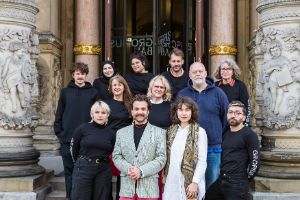
from top left to bottom right: Erikas Montoya, Nesrine Ben Mansour, Cennet Alkan, Christopher-Felix Hahn, Petra Petrick, Veronika Zimmer, Zorica “Lola” Radivojevic-Llalloshi, Jens Dierkes, Vera Moré, Hans Youssuf Kiesler, Miriam Ewering (Gropius Bau Education), Umut Azad Akkel; missing in the picture: Danae Yolanda Diettrich, Şehnaz Layıkel Prange, Niusha Ramzani
photo: Laura Fiorio
Jens Dierkes
on Ámà: The Gathering Place
Sometimes you only notice what things mean to you when they are gone. Emeka Ogboh’s installation is a gathering place centred on a big tree in the atrium of the Gropius Bau. The seating cubes of the “village square” invite visitors to rest and to exchange. The surrounding 12-channel sound installation accentuates the work with choral recordings of traditional Igbo folk songs every hour for 40 minutes. Treat yourself to the wonderful sound experience and walk the 12 loudspeakers one by one, listening to the voices in all their individual brilliance. When approaching the tree in their centre, these various vocals will unite in your ears as a complete choir experience. For me, this artistic work is a special place of exchange and a summoner of confidence and protection that performs almost as an actual village square.
Jens Dierkes has been working in the Gropius Bau since four years.
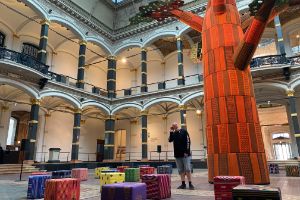
Emeka Ogboh, Ámà: The Gathering Place, 2021, installation view, Gropius Bau, Berlin
Umut Azad Akkel
on Beirut and the Golden Sixties: A Manifesto of Fragility
A narrow space with a lot of story/history, colours, feelings and dynamics: the exhibition Beirut and the Golden Sixties offers many paths to explore different but connected narratives. Narratives of a tired city that has experienced destruction and recreation at the same time, again and again.
One wall in the exhibition stands out: despite all the colours in the space, it is just black and white. On that wall we see works by Assadour Bezdikian (1977 and 1978). There is also a photograph of street combatants during the Lebanese Civil War (1976), which is much bigger in size than the artworks. This combination evokes the feeling that the artworks created the motivation and atmosphere for the photograph to be taken. The works have no colour (just black and white). The forms are really rigid and rough, as if there is no joy – just damage. In Bezdikian’s works we can observe how even the impact of every thrown stone is calculated. It is a familiar dystopic depiction that all pain and damage comes with a flipside. I read Bezdikian’s works as a wake-up call from a romantic salvation story that we might imagine during our exhibition visit. It is an opportunity to see the “final” explosion (installation) as a metaphor for collected pain, exhaustion, fight and struggle.
Umut Azad Akkel, Gropius Bau Friend and Berlin and Istanbul based artist
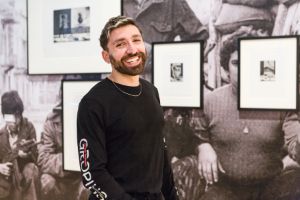
Umut Azad Akkel
Photo: Laura Fiorio
Nesrine Ben Mansour
on Dayanita Singh: Dancing with my Camera
When I stand in front of the Suitcase Museum, I think of movement and change. These motifs characterise the exhibition in many places, but here it becomes most clear to me how Dayanita Singh can pack up her “museums” and transport them to new places apparently without much effort. With the artist’s leather suitcases in mind, I think of how life itself is often described as a long journey. I also wonder – not for the first time, having current political happenings in mind – what I would pack in my suitcases. What objects make up my “museum”? What photos will be chosen to remember? The suitcase, despite the selection it demands, contains more than might be assumed at first glance. As an observer, I try to accept the many associations as an invitation to think away and further.
Nesrine Ben Mansour, Gropius Bau Friend and master’s student of cultural studies
Mila Panic
on Ámà: The Gathering Place
Being part of the Gropius Bau Friends really challenged my idea of what it means to be a friend to a visitor and how to embrace hospitality. How can one feel at home in a public space, and how can we as Friends make that transition comfortable? Ámà: The Gathering Place and its sound installation by Emeka Ogboh positioned in the heart of the Gropius Bau – the atrium – shows how important it is to have a common ground that is freely accessible to everyone and used by each in their own way. I see it as a living room of the Gropius Bau. Whether you take a break to rest your legs, open a book, check your messages, build a castle out of fabric cubes, or just warm up inside during this cold weather, this gathering place and its warm voices welcome everyone, just as we Friends do.
Mila Panic, Gropius Bau Friend and Visual Artist
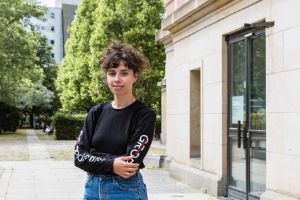
Mila Panic
Photo: Laura Fiorio
Duc Vu Manh
on The Cool and the Cold
Located in the area that was once the border dividing East and West Berlin, the Gropius Bau’s exhibition “The Cool and the Cold” deals with a deeply turbulent time in history. The group show brings together paintings from 1960 to 1990 from the U.S. and the ex-Soviet Union held by the Ludwig Collection. Like passing through time, the rooms are organised chronologically and thematically. Non-objective art and Socialist Realism are confronted in an exciting symbiosis – playful and serious at the same time.
At the end of the exhibition, arriving nearly at the turn of the century, it is obvious: What remains is not East or West, Soviet Union or United States, but art.
Duc Vu Manh, Gropius Bu Friend, art educator and master’s student of social work
Christopher-Felix Hahn
on the Gropius Bau’s architecture
Today, it’s rather hard to imagine the Gropius Bau was, until 1977, a burnt-out war ruin without a roof or windows in which trees grew wild. At the time, there were heated debates about the restoration of the building and its future use. I like the resulting compromise of not completely reconstructing the building, at least its interior. To this day, the building has something rather ruinous here and there: decapitated sculptures of old masters greet you at the portico, and when you look up inside you see blank brick walls right next to opulent Wilhelminian stucco ceilings. The imperial era, National Socialism and the German division have left their marks. Even though there are no memorial plaques or written information, the building calls on us in a subtle way to reflect. This is particularly evident in the large atrium frieze that originally showed representatives of different cultures and epochs presenting their “gifts” to Prussia. The frieze was badly damaged during the Second World War, and for me it symbolises the consequences that a nationalistic worldview can have for art and culture.
Christopher-Felix Hahn, Gropius Bau Friend, theatre producer and architecture historian
Niusha Ramzani
on Takeover. Plastic Catches Mushroom
I have a routine: at noon, I take a short break on the Südplatz. I like the place. Not only because I quite like to soak up some sun there, but also because the students from Picasso Grundschule (primary school) have transformed the square into a magical place of experience and encounter through their exhibition Takeover. Plastic Catches Mushroom. Here, I observe how visitors are surprised by sounds; how they look around and explore, experiencing a place they would otherwise only have passed by absentmindedly, now with all of their senses. With playful ease, the exhibition draws attention to all that is otherwise overheard and overlooked in the hustle and bustle of a technologised world and asks the question: can you hear nature growing?
Niusha Ramzani, Gropius Bau Friend and artist, social worker and art and philosophy student
Vera Moré
on the Kusama Kids Studio
When I am at the Gropius Bau as a Friend, I am always happy to observe how actively the children use the game in the Kusama Kids Booklet by the education team Ephra. They take their own space in the exhibition and in the building. They look for their own ways at their own speed and thus also break up the usual patterns in the exhibition space. I find that inspiring. In the Kusama Kids Studio, there is more space to reflect on the experiences, to paint, glue or read and simply spend some more time. Here I think that children and also adults make their own use of the Gropius Bau and are more relaxed.
Vera Moré, Gropius Bau Friend, cultural studies scholar and performance artist
Veronika Zimmer
on “becoming active yourself”
Hella Jongerius: Woven Cosmos is a fascinating exhibition: it combines millennia-old handicraft with today’s technology, aesthetically appealing, profound, energising and mindful. It contains art objects which entice me to touch them. They remind me of my own handicraft skills and/or those of other cultures. And what a surprise! I can become active myself, to create a rope together with other visitors in Dancing a Yarn. In a ritual in the form of a “dance” we concentrate, pay attention to each other, try to turn the hanging yarns in the same rhythm, in the same direction, and, if possible, even at the same speed. Coming together. Connecting ribbons. Release. Now the fabric ribbons turn on their own to form a rope. We marvel. Delighted. This work enables us to understand and dive deeper into this art. And perhaps what we create will become part of the artistic installations of this exhibition, which continuously develops. More of it!
Veronika Zimmer, Gropius Bau Friend and freelance cultural manager
Amelie Hornung
on the Gropius Bau Journal
As a student, I miss sitting in crowded library halls between buzzing heads and staring into my texts or at the ceiling. While studying and working at home, I miss sounds like the quiet rustling of book pages, yawning, sighing and the energy of many bodies. An online reading group can’t really replace this feeling. But if you understand study as “talking and walking around with other people, working, dancing, suffering…” (as Fred Moten and Stefano Harney summarise in their book The Undercommons), reading and sharing thoughts together can be a brief retreat from daily struggles. An opportunity to create a moment of conviviality through our words and voices, to give confidence and hope. On the online platform Gropius Bau Journal you can delve into exciting essays, interviews and artists’ texts, read them out loud or quietly, alone or together. It’s an inspiration for your self-organised reading group – or a prelude to events at the Gropius Bau, which will hopefully re-open soon.
Amelie Hornung, Gropius Bau Friend and student of German Philology, Philosophy and Education
Zorica “Lola” Radivojevic-Llalloshi
on Yayoi Kusama: A Bouquet of Love I Saw in the Universe
Recently, I much enjoyed building a snowman with my granddaughter. And it’s always so nice to gaze out the window and watch the seasons change. Often, my thoughts then turn to the immersive spaces of Yayoi Kusama. To me, her “Polka Dots” bear a strong resemblance to snowflakes, but also to flowers in bloom. I’m in great excitement because hopefully her exhibition now opens at the Gropius Bau in April.
Zorica “Lola” Radivojevic-Llalloshi, Gropius Bau Friend and museum guard at the Gropius Bau
Rosa-Lena Bösl
on Masculinities: Liberation through Photography
January, sleet and lockdown: fairly enticing to get all cozy on the couch. To break up the monotony, you may take a short walk with curator Alona Pardo through the exhibition Masculinities: Liberation through Photography. While strolling digitally through the Gropius Bau, past various images of masculinities over the course of time, you’re not only getting an impression of the exhibition, but also a desire to wander through the spacious galleries yourself soon again.
Rosa-Lena Bösl, Gropius Bau Friend and independent museologist
Petra Petrick
on the outside facade of the Gropius Bau
I am always amazed to see the Gropius Bau from the outside – one of the most impressive museum buildings! And a real “showcase” of handicrafts from the time of its construction in 1881. The fact that serial production was gaining traction then was seen as a threat to the continued survival of manual skills and artistic acumen. The large-scale terracotta depictions on the first and second floors, which surround the entire building, show master craftsmen at work in a lifelike manner (here basket weavers and printers). A walk around the building is a powerful reminder that the Gropius Bau was founded as a school for arts and crafts – and that it continues to pose questions about the relationship between arts and crafts today.
Petra Petrick, Gropius Bau Friend and photographer
Hans Youssuf Kiesler
on Otobong Nkanga’s Carved to Flow
Otobong Nkanga’s exhibition is entitled There’s No Such Thing as Solid Ground – and that’s exactly what it’s all about: ground, i.e. earth. In the Carved to Flow (2017–2020) project workspace, Nuno Vasconcelos, architect and researcher, works with different types of soil (coarse, pebbly, stony, fine, ...) to create the right mixture for building a solid wall. The highlight, however, is Nuno himself. You start a conversation, experience earth in a new way, share views, discover ideas and can always get your hands dirty, too.
Hans Youssuf Kiesler, Gropius Bau Friend and actor
Şehnaz Layıkel
on Lee Mingwei’s Guernica in Sand
Nothing is permanent, everything is changeable and limited in relation to time. I particularly like the installation Guernica in Sand (2006/2020) by Lee Mingwei because it addresses the possibility of transforming trauma. Sand can be washed away by ocean waves, the wind or a ritual. Lee Mingwei transformed his sand painting through the performance of such a ritual, with people walking through the sand to turn an image based on Picasso's famous painting Guernica (1937) into an abstract form. Although the traces of the past can still be seen and memorised, we encounter a completely new image. For me it’s a metaphor for time and hope.
Şehnaz Layıkel, Gropius Bau Friend and PhD candidate at the Berlin University of the Arts
Lindi B.
on Otobong Nkanga’s Manifest of Strains
Air, water, fire – I particularly like the work Manifest of Strains (2017), because it combines these natural elements with emotional, social and political conditions and also makes these tangible: just as water evaporates into air through heat, other conditions merge into each other and create tension, which discharges itself in the installation’s circuit with a loud hiss – it always gives me a little goose bumps.
Lindi B., Gropius Bau Friend and student of cultural studies
Previously:
Cennet Alkan, Lindi B., Rosa-Lena Bösl, Jens Dierkes, Danae Yolanda Diettrich, Christopher Hahn, Amelie Hornung, Nataša Jagdhuhn, Hans Youssuf Kiesler, Ralph-Jürgen Lischke, Duc Vu Manh, Nesrine Ben Mansour, Paul Maragnoli, Vera Moré, Mila Panic, Şehnaz Layıkel Prange, Niusha Ramzani
At the beginning, the project was consulted by Julia Moritz and supported by an interdisciplinary advisory board, formed by Jens Dierkes, Kolja Kohlhoff, Necati Öziri, Carlos Rodriguez and Stephanie Rosenthal. During winter semester 2019/20 at Leuphana University Lüneburg, a seminar led by Prof. Dr. Söntgen and Alia Rayyan examined the project with students of cultural studies.
Funded by